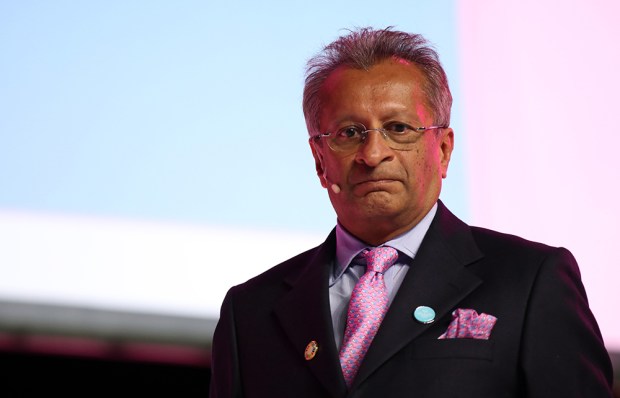Whether you’re left, right or just somewhere vaguely in between, wherever you’re coming from you may well have a sense that things are somehow not quite right, that the country is headed in the wrong direction, that our various problems and crises seem to be multiplying. You may well have concluded that this is because our institutions have been taken over by an out-of-touch elite who run the government, the judiciary, the media and goodness knows what else, and that the only way to discover the real truth is to do your own research, which involves scrolling through the internet because you no longer trust the ‘mainstream media’.
If so, without knowing it, according to James Ball, you have been infected by QAnon. In this brilliant, wide-ranging, if rather uneven, account, Ball argues that all sorts of conspiracy theories, originally bred in the depths of chat rooms, bulletin boards and what he calls ‘digital reservoirs’, have gradually found their way into everyday mainstream culture, and that – unless prevented from spreading – they will continue to cause massive damage to our democratic system. The Other Pandemic is essentially a history of some recent bad ideas brought to us by the internet.
Ball is a journalist who spent a lot of his teens on 4chan, a collection of online forums founded in 2003 by a 15-year-old American, Christopher Poole, known as ‘moot’. For those who might be unfamiliar, 4chan is essentially a message board like, say, Mumsnet, which guarantees anonymity to users and which Ball describes as ‘just a ridiculously fun place to hang out’. The anonymity has also meant that it’s a place which has enabled and encouraged the sort of loose talk, bullying and idiotic pranks that might once have been restricted to school playgrounds, pubs, public toilets and the privacy of one’s own home. Thus, 4chan brought us harmless memes, lolcats and Rickrolling, but also trolling, doxing and revenge porn. Ball sums up the early days of the site as a place where ‘bored, online-literate misfits’ used ‘their excess energy on whatever crossed their minds, with no particular target’. And then they found their targets.
The first serious one was the Church of Scientology, which became subject to online attacks in 2008 by a group of 4chan users who called themselves Anonymous. These attacks soon became real world protests involving the picketing of Scientology centres by people wearing Guy Fawkes masks. In other words, with Anonymous, the online world began seeping into the real one.
Things got worse. Various pranks, scams and trolling eventually led to something known as Gamergate, again spawned on 4chan. This particularly sorry episode in internet history was essentially a harassment campaign against women which provided plenty of fuel and impetus for incel online subculture, the alt-right and the many useful idiot YouTube hucksters and social media influencers who like to peddle hokum, hogwash and hate in order to boost likes, subscribes and views. From this roiling hot digital stew eventually emerged Pizzagate, in 2016, the first big viral conspiracy theory, which suggested that Hillary Clinton led a human trafficking and child-sex ring, centred on a pizzeria in Washington DC.
And then came Q. Q is a term for a high level of security clearance in the US Department of Energy. In 2017, a 4chan user with the name ‘Q Clearance Patriot’ began posting. Q may or may not be Ron Watkins, the son of Jim Watkins, who happens to be the owner of something now called 8kun, and which, in Ball’s words, is ‘essentially 4chan, but worse’. Whether Watkins or not, Q’s posts gathered quite a following. As Ball explains, ‘the QAnon conspiracy is a hard one to fully define’, but the essentials are that ‘the world is run by a satanic, paedophilic elite’ and that Donald Trump is waging a heroic battle against these dark forces. The attack on the United States Capitol on 6 January 2021, following Trump’s defeat in the 2020 presidential election, represented QAnon in action.
As if all this weren’t bad enough, Ball goes on to explain how QAnon conspiracy theories then merged with ideas about the ‘Great Reset’, the anti-vaccine and anti-lockdown movements, quickly becoming ‘the conspiracy theory that has eaten all other conspiracy theories’, underpinned by various fantasies, nostalgic longings and an all-pervasive belief in a morally bankrupt elite ‘other’.
It’s difficult to see how to cope with this ongoing tidal wave of online misinformation and disinformation. Rather overextending his metaphor, Ball suggests a ‘Digital Public Health System’ to counter the threat of ‘digital pathogens’. Whatever the cure – and let’s hope there is a cure – The Other Pandemic presents a detailed and disturbing diagnosis.
Got something to add? Join the discussion and comment below.
Get 10 issues for just $10
Subscribe to The Spectator Australia today for the next 10 magazine issues, plus full online access, for just $10.
You might disagree with half of it, but you’ll enjoy reading all of it. Try your first month for free, then just $2 a week for the remainder of your first year.














Comments
Don't miss out
Join the conversation with other Spectator Australia readers. Subscribe to leave a comment.
SUBSCRIBEAlready a subscriber? Log in